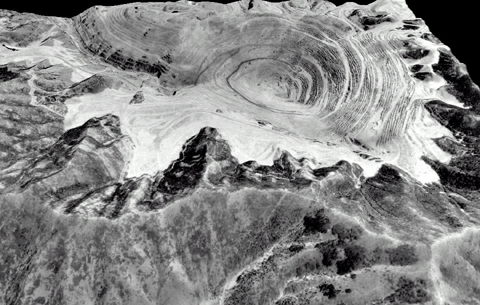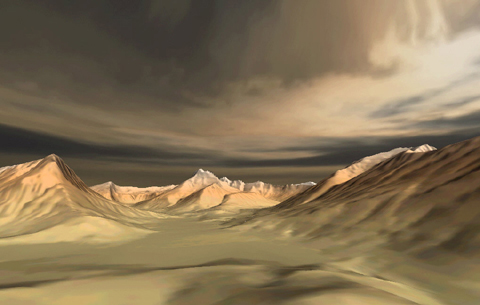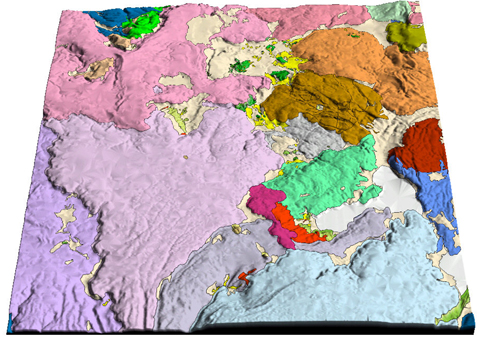Virtual Vistas: Digital Technologies to Visualize EarthIn this section, students will find brief descriptions of interesting or
unique geologic settings that illustrate some of the processes and phenomena
studied in each chapter - but with a 21st Century twist. During the last decade
or so, many maps and other sources of geospatial data have been acquired using
digital technologies of various kinds. Additionally, old maps and aerial photographs
have been converted to digital formats.
 <a onClick="window.open('/olcweb/cgi/pluginpop.cgi?it=jpg::Aerial photograph of the Bingham Canyon copper mine, Utah, USA::/sites/dl/free/0072826967/30425/VirtualVista2104.jpg','popWin', 'width=NaN,height=NaN,resizable,scrollbars');" href="#"><img valign="absmiddle" height="16" width="16" border="0" src="/olcweb/styles/shared/linkicons/image.gif">Aerial photograph of the Bingham Canyon copper mine, Utah, USA (141.0K)</a>Aerial photograph of the Bingham Canyon copper mine, Utah, USA <a onClick="window.open('/olcweb/cgi/pluginpop.cgi?it=jpg::Aerial photograph of the Bingham Canyon copper mine, Utah, USA::/sites/dl/free/0072826967/30425/VirtualVista2104.jpg','popWin', 'width=NaN,height=NaN,resizable,scrollbars');" href="#"><img valign="absmiddle" height="16" width="16" border="0" src="/olcweb/styles/shared/linkicons/image.gif">Aerial photograph of the Bingham Canyon copper mine, Utah, USA (141.0K)</a>Aerial photograph of the Bingham Canyon copper mine, Utah, USA
Whereas geologists once relied on large format paper maps to depict many
geologic associations, the ability to visualize geologic phenomena using digital
data is an increasingly valued tool among research geologists of the 21st
Century.
 <a onClick="window.open('/olcweb/cgi/pluginpop.cgi?it=jpg::Digial terrain model of a portion of Glacier National Park, Montana, USA::/sites/dl/free/0072826967/30425/VirtualVista1201.jpg','popWin', 'width=NaN,height=NaN,resizable,scrollbars');" href="#"><img valign="absmiddle" height="16" width="16" border="0" src="/olcweb/styles/shared/linkicons/image.gif">Digial terrain model of a portion of Glacier National Park, Montana, USA (97.0K)</a>Digial terrain model of a portion of Glacier National Park, Montana, USA <a onClick="window.open('/olcweb/cgi/pluginpop.cgi?it=jpg::Digial terrain model of a portion of Glacier National Park, Montana, USA::/sites/dl/free/0072826967/30425/VirtualVista1201.jpg','popWin', 'width=NaN,height=NaN,resizable,scrollbars');" href="#"><img valign="absmiddle" height="16" width="16" border="0" src="/olcweb/styles/shared/linkicons/image.gif">Digial terrain model of a portion of Glacier National Park, Montana, USA (97.0K)</a>Digial terrain model of a portion of Glacier National Park, Montana, USA
For each chapter of this Online Learning Center, a "virtual vista"
was created from publicly available geospatial data sets. Digital maps of
topography or geology, digital terrain data, and digital aerial photographs
were combined to create realistic views of interesting geologic locations
or phenomena.
 <a onClick="window.open('/olcweb/cgi/pluginpop.cgi?it=jpg::Geologic map on digital terrain model of Yellowstone National Park, Wyoming, USA::/sites/dl/free/0072826967/30425/VirtualVista1102.jpg','popWin', 'width=NaN,height=NaN,resizable,scrollbars');" href="#"><img valign="absmiddle" height="16" width="16" border="0" src="/olcweb/styles/shared/linkicons/image.gif">Geologic map on digital terrain model of Yellowstone National Park, Wyoming, USA (191.0K)</a>Geologic map on digital terrain model of Yellowstone National Park, Wyoming, USA <a onClick="window.open('/olcweb/cgi/pluginpop.cgi?it=jpg::Geologic map on digital terrain model of Yellowstone National Park, Wyoming, USA::/sites/dl/free/0072826967/30425/VirtualVista1102.jpg','popWin', 'width=NaN,height=NaN,resizable,scrollbars');" href="#"><img valign="absmiddle" height="16" width="16" border="0" src="/olcweb/styles/shared/linkicons/image.gif">Geologic map on digital terrain model of Yellowstone National Park, Wyoming, USA (191.0K)</a>Geologic map on digital terrain model of Yellowstone National Park, Wyoming, USA
It is hoped that the short descriptions and imagery that accompany each "Virtual
Vista" will intrigue you (and perhaps even your professor!) in such a
way that you will be motivated to learn more on your own. The samples provided
in this Online Learning Center are but a very small peek into the fascinating
(and growing) area of digital geology. For an example of the marvelous capability of digtial geospatial technologies,
click on the link below to take a virtual flight over the Los Angeles Basin.
Chapter 1 of your text introduced you to the relevance of Geology in all
our lives. Perhaps no other single location can summarize the importance of
geology, geological processes, and geological materials in our lives than
the remarkable development of the Los Angeles Basin, California. Here, approximately
11 million people have settled between the mountains and the Pacific Ocean.
For these people, geological processes and products (sometimes imported great
distances) provided all of the water, all of the building materials (try to
imagine the geological sources of materials for the road systems in the L.A
Basin alone), all of the essential nutrients for the food they consume, and
all of the energy they utilize. In addition, these 11 million people live
with the ever-present danger of a major earthquake due to the unique geological
setting of the L.A. Basin. This Virtual Vista is a brief overflight of a part of L.A. Basin that symbolizes
human-kind's apparent disconnection and distance from the natural processes
governing geology - Hollywood! This simulated night-time overflight looks
southward over the famed Hollywood Hills. The relatively sparse development
of the hills (in the central part of the view) is evident by the lack of artificial
lighting . Beyond the relatively dark Hollywood Hills lies the city of Hollywood
and other communities of the Los Angeles Basin, stretching to the horizon.
In the foreground, communities of the San Fernando Valley are well-lit and
plainly evident. This scene plays out every night, 365 days each year.  Hollywood Fly By (3813.0K) Hollywood Fly By (3813.0K)
Points to Ponder: 1. Try to imagine the total quantity of geological resources required to create and
sustain this show as you view the video 2. Try to imagine how much
humans depend on geological materials worldwide 3. Try to create a list of 10 materials that you use each day that do not ultimately depend on geological processes.
Having trouble loading or viewing the video clip? You will need the DivX video codec for your media player to watch the video. The DivX codec is available free from www.divx.com. Click on the link or type the URL into your browser to go to the DivX download site. Once at the DivX site, follow the "DOWNLOAD" links until you locate the download "Standard DivX Codec (FREE)" hyperlink. Click on the link and download the small DivX codec file. The codec file may take a few minutes to load. Please be patient. Once the file is downloaded to your local computer, double click on the file to automatically install the Divx codec.You may also discover that the Virtual Vistas work best with the Windows Media Player, available as a free download from www.microsoft.com. Click on the link or type the URL into your browser to go to the Microsoft web site. Once at the web site, type "windows media player" into the Search box, then click on the appropriate link to download the latest version of Windows Media Player. |



